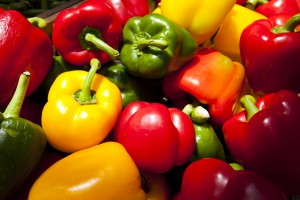5 Tricks to Switch Up Your Veggie Routine
It’s easy: Eating more vegetables is key to weight loss. If you’ve been trying to lose stubborn fat but you’re still having a hard time, chances are you need to increase the amount of vegetables you and your family eat.
But vegetables can be “scary” to picky eaters and inexperienced cooks.
Today I got a question from a reader about vegetables.
Hi Chef,
We’re struggling with eating vegetables here. We tend to rely on the same ones over and over again: broccoli, carrots, and celery. Any fresh ideas? How do you cook them? I heard that cooking destroys all nutrients?
Dawne
Answer:
Hi, Dawne. It can be difficult, but here are five easy tricks to get out of the routine.
#1 Variety is kind
When it comes to vegetables, eating a variety of them is what matters the most. The more KINDS of vegetable you eat, the more chance you have to fill up on essential nutrients, and significant fiber. Fiber is what makes you feel full, and eliminates those blood sugar spikes that lead to fat gain.
Eat some raw
Try raw radishes (with a bit of butter and salt! Delicious), edamame, asparagus (yes, they’re excellent raw!), and raw broccoli (maybe with raisins, nuts, and a nice homemade salad dressing).
Eat some cooked
Try new ones: Dandelion greens, kohlrabi, romanesco, bok choy, beets (<= give beets another try. Just avoid the canned ones.).
Buy every kind
Try some leafy greens (spinach, kale, chard, collards), some root vegetables (rutabaga, turnips, beets), some squash (butternut, acorn, spaghetti), some Mediterranean (zucchini, eggplant, yellow squash), some legumes (chickpeas, black beans, navy beans, lentils), or green (asparagus, peas, broccoli, Brussells sprouts).
Remember, every kind of vegetable cooks the same way. Wilt all leafy greens, roast all root vegetables, grill all Mediterranean, steam all green veggies, and add legumes to soups and stews.

Think color
Don’t eat beige food! The more colors, the better. Make it colorful and exciting.
#2 Keep them crunchy
Cooking destroys some, but not all nutrients. However, it’s best to keep all vegetables nice and crunchy by cooking them a minimum amount of time. Almost undercooked = more fiber, more vitamins, and more flavor.
#3 Overcooking can lead to weight gain
Believe it or not, raw carrots have a low Glycemic Index (good!) but when cooked, their GI skyrockets (bad!).
Rule of thumb: Stay away from a mushy consistency (think mashed potatoes or overcooked carrots).
#4 Know your techniques
Recipes won’t tell you how to cook vegetables. Cooking techniques will. So learn or perfect techniques such as wilting, sautéing, roasting, and steaming. These 4 techniques only will free you from recipes and allow you to cook all vegetables mentioned above to your liking, in a matter of minutes.
#5 Don’t worry too much
Enjoy food! Remember what I always say: Eat More, Burn More. No guilt. The important thing is to eat vegetables. If you can’t eat them raw, cook them and eat them. You are still getting plenty of goodness.
![]()